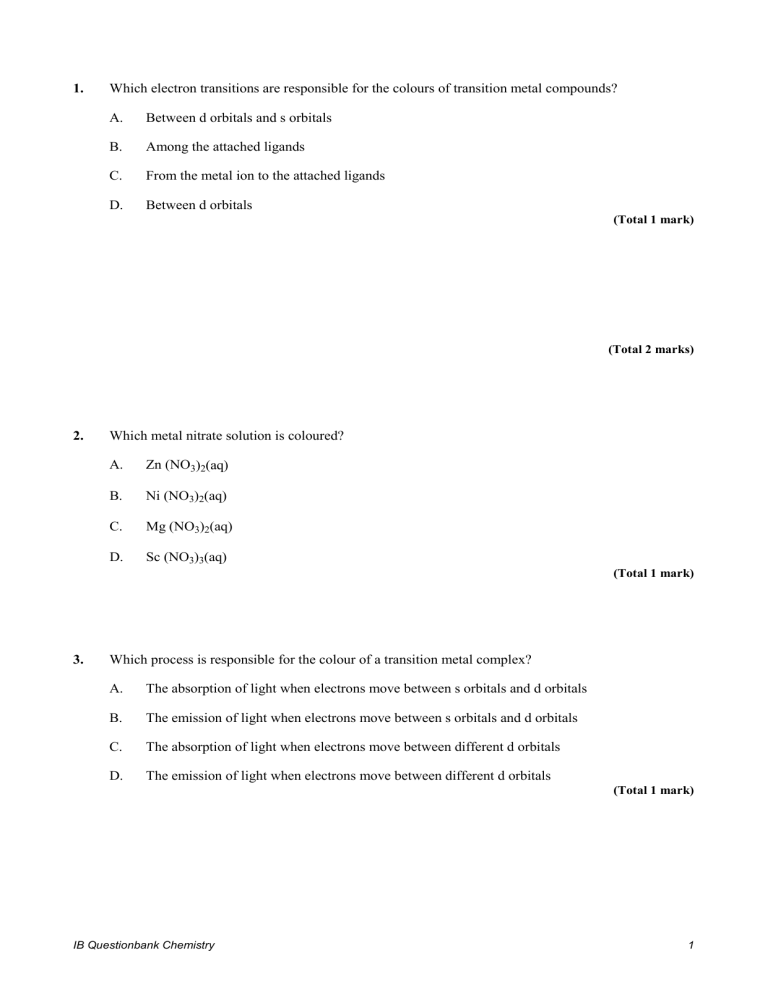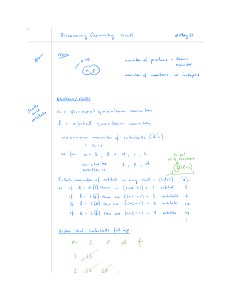
1. Which electron transitions are responsible for the colours of transition metal compounds? A. Between d orbitals and s orbitals B. Among the attached ligands C. From the metal ion to the attached ligands D. Between d orbitals (Total 1 mark) (Total 2 marks) 2. Which metal nitrate solution is coloured? A. Zn (NO3)2(aq) B. Ni (NO3)2(aq) C. Mg (NO3)2(aq) D. Sc (NO3)3(aq) (Total 1 mark) 3. Which process is responsible for the colour of a transition metal complex? A. The absorption of light when electrons move between s orbitals and d orbitals B. The emission of light when electrons move between s orbitals and d orbitals C. The absorption of light when electrons move between different d orbitals D. The emission of light when electrons move between different d orbitals (Total 1 mark) IB Questionbank Chemistry 1 4. Which salts form coloured solutions when dissolved in water? I. II. III. FeCl3 NiCl2 ZnCl2 A. I and II only B. I and III only C. II and III only D. I, II and III (Total 1 mark) 5. When concentrated hydrochloric acid is added to a solution containing hydrated copper(II) ions, the colour of the solution changes from light blue to green. The equation for the reaction is: [Cu(H2O)6]2+(aq) + 4Cl–(aq) → [CuCl4]2–(aq) + 6H2O(l) (i) Explain what the square brackets around the copper containing species represent. ...................................................................................................................................... ...................................................................................................................................... (1) (ii) Explain why the [Cu(H2O)6]2+ ion is coloured and why the [CuCl4]2– ion has a different colour. ...................................................................................................................................... ...................................................................................................................................... ...................................................................................................................................... ...................................................................................................................................... ...................................................................................................................................... (2) (Total 3 marks) 6. Explain the origin of colour in transition metal complexes and use your explanation to suggest IB Questionbank Chemistry 2 why copper(II) sulfate, CuSO4(aq), is blue, but zinc sulfate, ZnSO4(aq), is colourless. ................................................................................................................................................ ................................................................................................................................................ ................................................................................................................................................ ................................................................................................................................................ ................................................................................................................................................ ................................................................................................................................................ ................................................................................................................................................ (Total 4 marks) 7. (i) State the full electronic configurations of copper, Cu, and the copper(I) ion, Cu+. (2) (ii) Explain why copper(II) compounds in aqueous solution are coloured whereas scandium(III) compounds in aqueous solution are colourless. (2) (Total 4 marks) IB Questionbank Chemistry 3




